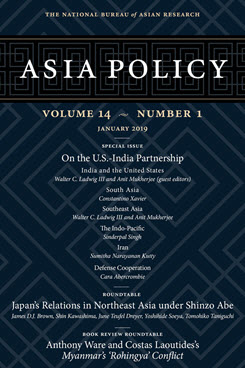Seeking Stability: Japan’s Relations in Northeast Asia under Shinzo Abe
This Asia Policy roundtable takes stock of Japan’s current political and economic relations with its Northeast Asian neighbors and the United States.
Abe’s Russia Policy: All Cultivation and No Fruit
James D.J. Brown
Japanese Diplomacy and the “Improvement” in Sino-Japanese Relations
Shin Kawashima
The Japan-Taiwan Relationship: An Unstable Stability
June Teufel Dreyer
Japan and Peace on the Korean Peninsula: The Need for a Flexible Approach
Yoshihide Soeya
Japan: A Stabilizer for the U.S.-Led System in a New Era
Tomohiko Taniguchi
Introduction
Northeast Asia is one of the world’s most complex security environments—a region home to three nuclear weapons states, great-power rivalry, multiple territorial conflicts, and long historical memories. In this environment, Japan must deftly navigate its relations with its neighbors against a backdrop of growing uncertainties about the international order. Under Prime Minister Shinzo Abe’s leadership, the country has taken unprecedented steps toward “normalizing” its international posture, introduced a new “free and open Indo-Pacific” strategy, bolstered its defenses, and strengthened relations with its ally and security guarantor, the United States. At the same time, Japan has assumed a new leadership role in regional economic and diplomatic initiatives, such as bringing the Comprehensive and Progressive Agreement for Trans-Pacific Partnership to fruition following U.S. withdrawal from the Trans-Pacific Partnership agreement.
This Asia Policy roundtable takes stock of Japan’s current political and economic relations with its Northeast Asian neighbors and the United States. Focusing on Japan’s relations with Russia, China, Taiwan, the two Koreas, and the United States, the essays assess Tokyo’s priorities and policies and note salient issues to watch in each bilateral relationship over the next two to three years.
Since returning to power in December 2012, Abe has sparked new momentum in Japan’s relations with Russia and has committed to resolving the territorial dispute over the Northern Territories/Kuril Islands. James D.J. Brown examines Abe’s efforts to cultivate ties with Russia and create the conditions for a resolution while arguing that a favorable deal is still likely to prove elusive. Shin Kawashima traces the trajectory of Japan-China relations to contend that the recent so-called improvement in their relationship is in reality a return to a more neutral state. He then looks at how Japan is striking a balance between Chinese and U.S. initiatives for Asia. June Teufel Dreyer addresses another delicate balance in Japanese foreign relations—that of Taiwan. Japan-Taiwan relations are developing in a generally positive direction, given shared democratic values, history, and strategic calculations, but remain constrained by the prospect of angering China. On the Korean Peninsula, North Korea continues to be a major source of regional instability. Yoshihide Soeya analyzes Japan’s interpretation of developments in the North Korean crisis and related interactions with South Korea and the United States in response, and he suggests strategic and political options for the coalition of involved states in the future. Last, and perhaps key to achieving a sense of stability in this insecure environment, Japan under Abe has concentrated on reinvesting in its relationship, and in particular the bilateral security alliance, with the United States. Tomohiko Taniguchi shows how Abe has done this by both making it easier for the United States to maintain a presence in Japan and demonstrating that a continued presence in the Indo-Pacific is in the best interest of the United States.
Taken together, these essays depict a more assertive and internationally minded Japan than in recent years. Under Abe, the country has sought to promote its political, security, and economic goals in a challenging regional environment beset by a changing balance of power, nuclear proliferation on the Korean Peninsula, provocative behavior by China in the East China Sea, competing economic arrangements, and concerns about the possible withdrawal of the United States from its traditional role. As Taniguchi puts it, Japan is choosing to play the role of a “system stabilizer.” Its efforts to do so remain important to watch.
About Asia Policy
Asia Policy is a peer-reviewed scholarly journal presenting policy-relevant academic research on the Asia-Pacific that draws clear and concise conclusions useful to today’s policymakers. Asia Policy is published quarterly in January, April, July, and October and accepts submissions on a rolling basis. Learn more


